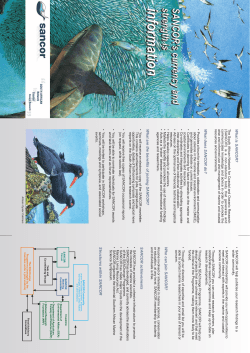
Document 385411
Characteristics of the Marine Biome • cover 71% of the Earth’s Surface. • Some places of the ocean floor are deeper than Mt. Everest is high. • 96.5% of the ocean is pure water • 3.5% is dissolved minerals Factors Effecting the Composition of Marine Waters • Air – The levels of oxygen (O2) and carbon dioxide (CO2) in the water are greatly effected by the air • Disasters – Hurricanes, typhoons, and tsunamis weather and erode the coastal regions washing sediments into the ocean • Human activities Discuss with your neighbors. – What activities affect marine biomes? – What are some biotic and abiotic components of marine biomes? Components of the Marine Biome • Abiotic (nonliving) – Water – Sunlight/darkness – Minerals – Dissolved gases • Biotic (living) – Producers – Consumers – Decomposers Obtaining Energy in the Marine Biome • Autotrophs- phytoplankton and plants capture energy from the sun • Chemotrophs- some Archaebacteria obtain energy from the chemicals around deep sea vents • Heterotrophs- consumers obtain energy by feeding on other living organisms Producers of the Ocean • Two types of Producers – Photosynthetic • Organisms living close enough to the surface to obtain energy from the sun • Convert carbon dioxide (CO2) into sugars • Ex. Phytoplankton, diatoms and kelp – Chemosynthetic • Organisms living around deep-sea vents • Have no light for photosynthesis • Convert hydrogen sulfide (H2S) and elemental sulfur into organic molecules • Ex. Archaebacteria Photosynthetic vs. Chemosynthetic Primary Consumers • Eat the producers herbivores – Sea urchins – eat kelp – Sea butterflies – feed on phytoplankton – Parrot fish – eat algae Secondary Consumers • Eat the primary consumers – carnivores or omnivores – Jelly fish – eat small fish – Clown fish – eat small invertebrates – Sea otters – eat sea urchins Tertiary Consumers • Eat the secondary consumers – Polar bears – eat seals, walrus, and beluga whales – Great White sharks – eat dolphins, sharks, whales, sea lions, sea turtles and sea birds – Bull sharks – eat dolphins, rays, sea turtles and sea birds Decomposers • Filter Feeders – remove dead materials floating in the water – Ex. Tube worms and anemones • Bottom Feeders – break down dead materials that has made its way to the ocean floor – Ex. Sea Cucumbers and Star Fish Let’s put this together… • Based on what you know – Draw an example of a food chain in the Marine Biome. – Give examples of things that would alter your food chain. Flow of Energy in the Ocean Sun or Deep Sea Vent Producers Primary Consumers Secondary Consumers Tertiary Consumers Flow of Matter and Energy in the Ocean Adaptations to the Marine Biome • Adaptations of organisms in the oceans that help survival. • These include… 1. 2. 3. 4. Breathing in water Protection Sensory adaptations Communication Adaptations: Exchange of Gases • Deep Sea Worms – exchange gases directly through their bodies • Plants –exchange O2 for CO2 through specialized openings in their leaves (stomata) • Vertebrates – exchange CO2 for O2 through gills. Examples of Plant Adaptations • Kelp (sea weed) – – Holdfast • Root like structure to anchor the plant the ocean floor • Not for absorbing nutrients – Gas Bladders • Bubble-like structures filled with air • Allow the plant to float at the surface of the water – Stoma • Opening where gases are exchanged between the plant and the environment Examples of Animal Adaptations • Hermit Crabs – Live inside the shells of others for protection – Behavioral – Crab lifts anemones onto its shell so that anemone provides protection – The anemone benefits can feed on the crabs leftovers • Sea Anemone – Have special stinging cells for attack and protection Click here for movie Adaptation: Protection • Coloration – – Camouflage • Chemical – – Bitter tasting – Poisonous • Avoidance – – Speed – Large numbers Adaptation: Communication – Bioluminescence provides a way for creature of the deep to communicate Click image • Deep Sea Creatures • Dolphins Click image – Vocalize using clicks and squeaks REVIEW 1. How is a marine biome different from a freshwater biome? – Marine biomes are larger, interconnected, and contain dissolved minerals like salt. 2. What are the two ways Producers get food? – Autotrophs get energy from the sun, Chemotrophs get energy from chemicals found in deep vents. 3. Name three organisms of the marine biome and discuss two adaptations of each.
© Copyright 2025





















